Kibbeh Nayeh is a Lebanese dish made with raw beef and served with pitas on special occasions. It’s a simple, traditional dish to make that is absolutely delicious!
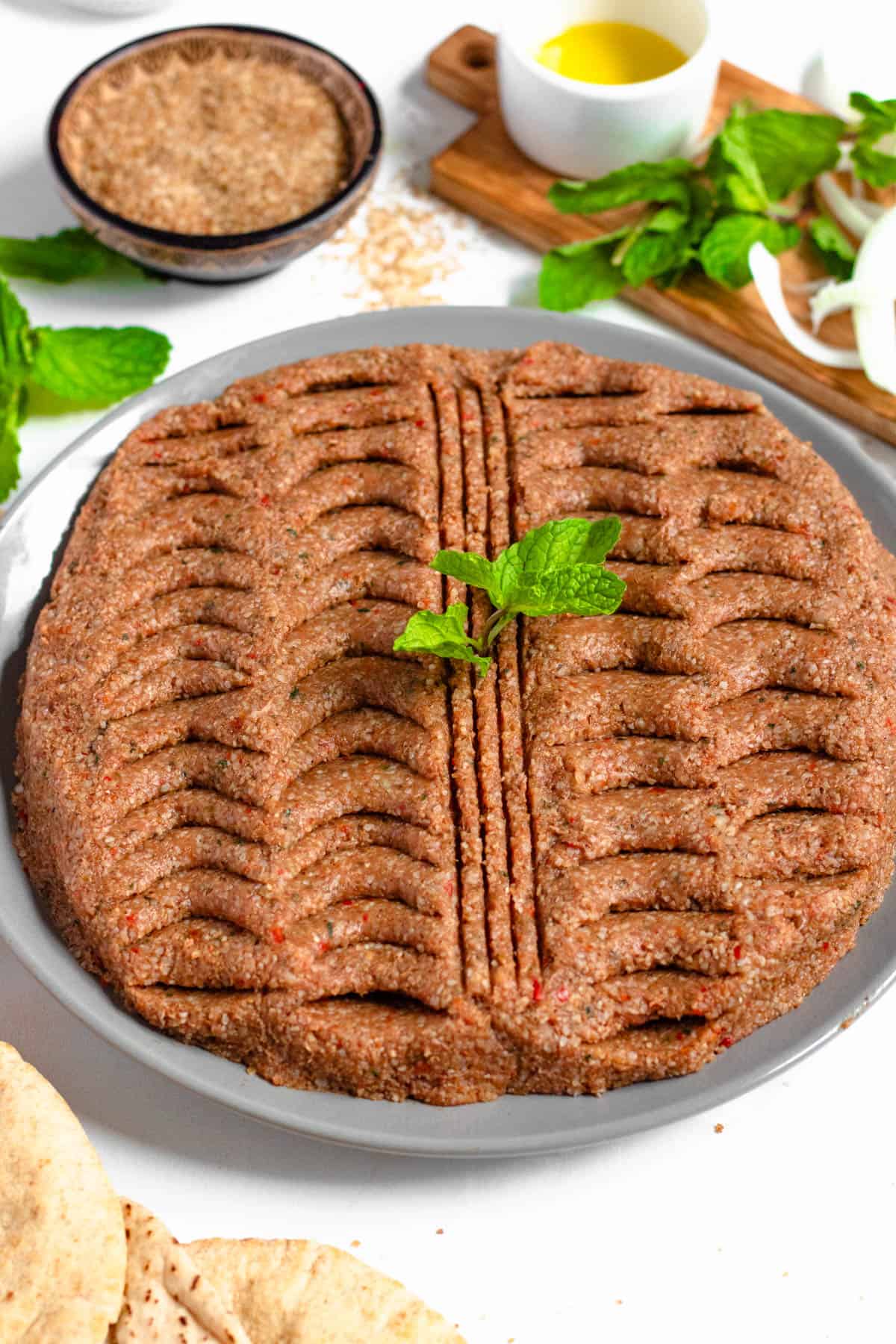
Hello Reader! I try my hardest to research recipes as best as I can before posting to ensure I am representing each culture correctly. If this recipe is from your country and I have made a mistake or you have suggestions for how to make it more authentic, I would love to hear! Please leave a comment below letting me know what should be different, and I will rework the recipe. It is always my intention to pay homage and respect to each cultural dish that I cook. Thanks for reading!
Kibbeh Nayeh is a traditional Lebanese dish that may surprise you in more than one way.
The first way is yes, it is raw meat. The next surprise is how flavorful and delicious you may find this raw dish to be.
Kibbeh Nayeh isn’t made of just any raw meat. It must be the freshest, leanest piece of red meat possible. Blended with onions, bulgur wheat, and a flavorful mix of fresh herbs and spices, it’s a dish you won’t forget.
Recipe Origin
Kibbeh Nayeh is a very traditional meal and may even go back to the old days of Abraham. This quintessential Lebanese dish was created when the Lebanese and Syrians would kill an animal for Sunday dinner or special occasions and immediately use the fresh, raw meat to prepare Kibbeh Nayeh to ensure safe consumption.
Over time our ability to preserve meat has increased greatly, but this nostalgic dish is still treasured and the high-quality, fresh meat is still its defining factor. In fact, it is the national dish of Lebanon.
You may not find this dish in more urban areas or on many restaurant menus, but it has held its significance and popularity among Arab populations for centuries.
There are many different kinds of Kibbeh. You may see it fried in football-shaped Kibbeh balls or even vegan varieties made with potatoes instead of meat. This recipe is a more traditional version made with the raw meat that the rest of the Kibbeh dishes are based on.
Why Make This Recipe
- Authentic Experience: This isn’t a dish you can make on the fly. It takes some preparation to find the right cut of meat and ensure it is prepared safely, but the experience is truly authentic. This is a dish that has been passed down for generations.
- Simple Ingredients: This dish does not require anything complex. It’s made with pure and fresh ingredients.
- Taste of Lebanon: This dish brings tradition to life with a flavor and texture that melts in your mouth. For another taste of Lebanon, try using this 7 Spice Recipe in your everyday cooking!
What Do You Need to Make This Recipe?
Ingredients
Here is a visual overview of the ingredients in the recipe. Scroll down to the recipe at the bottom for quantities.
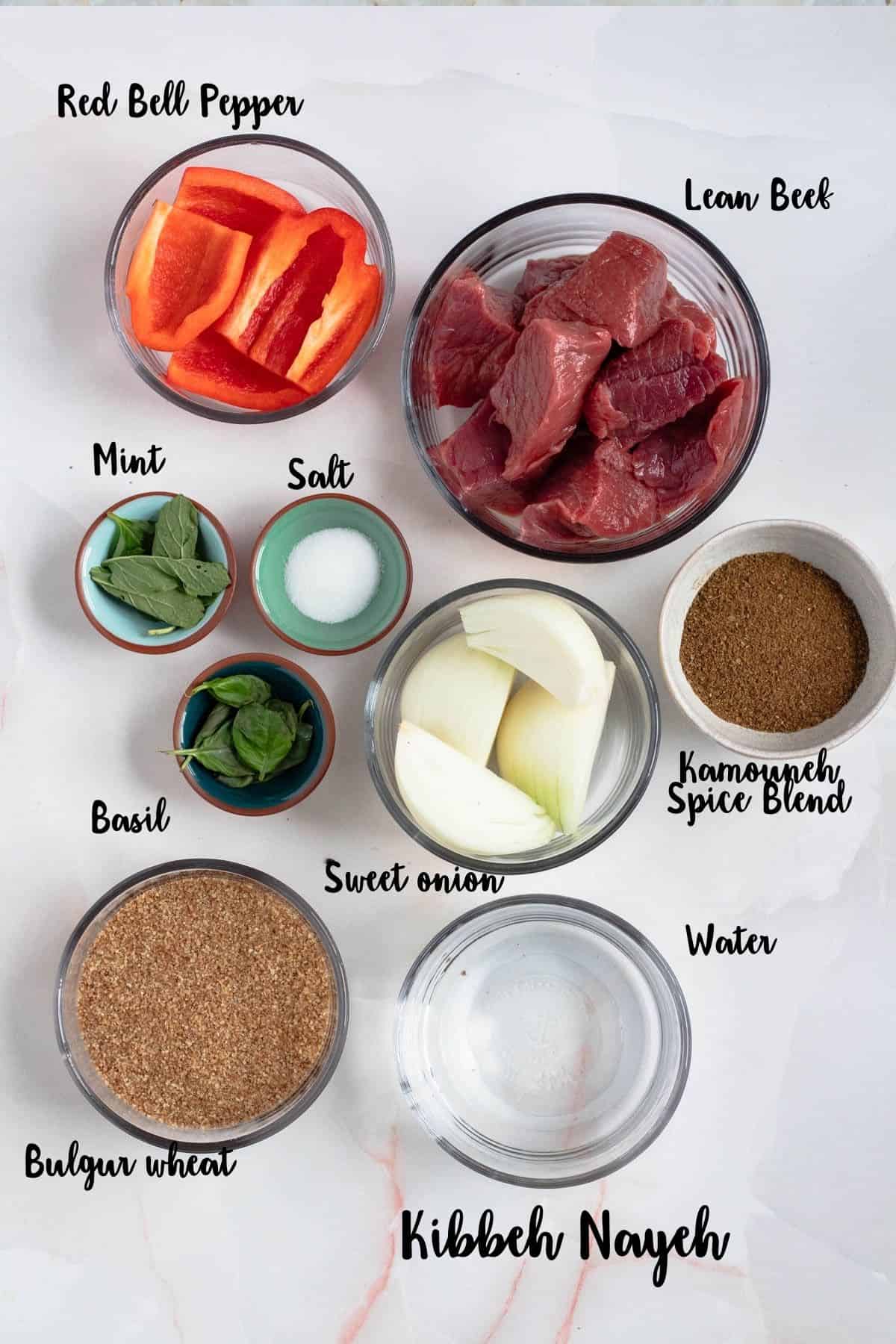
- Bulgur Wheat: Bulgar wheat is cracked wheat. I was told to use Red Bulgur Wheat but any kind will do. Fine bulgur wheat will give a better, more delicate texture to the dish. Make sure you use Bulgur #1, which is the finest grain of bulgur!
- Water: You will need to soak your bulgur wheat before using so that is the right texture for mixing with the meat!
- 100% Lean Beef: This dish is traditionally made with beef, lamb or veal. You should only use meat purchased directly from a butcher, and make sure you trust your butcher to give you safely preserved meat. My butcher gave me top round beef. Make sure there is no fat on the meat at all.
- Red Pepper: This is optional. Some people add red pepper, which is an especially beautiful addition for color. If you would prefer to omit the red pepper, you certainly can!
- Sweet Onion: I’ve also seen Kibbeh made with white onion. Feel free to substitute that if you prefer!
- Herbs: Fresh Mint & Basil Leaves.
- Kamouneh Spice Blend (Kibbeh Seasoning): You can find this at a local Middle Eastern Grocery store or make your own using this recipe.
Tools:
- Food Processor
- Large Bowl
- Serving Platter
How to Make This Recipe
Step One: Prepare the Bulgur
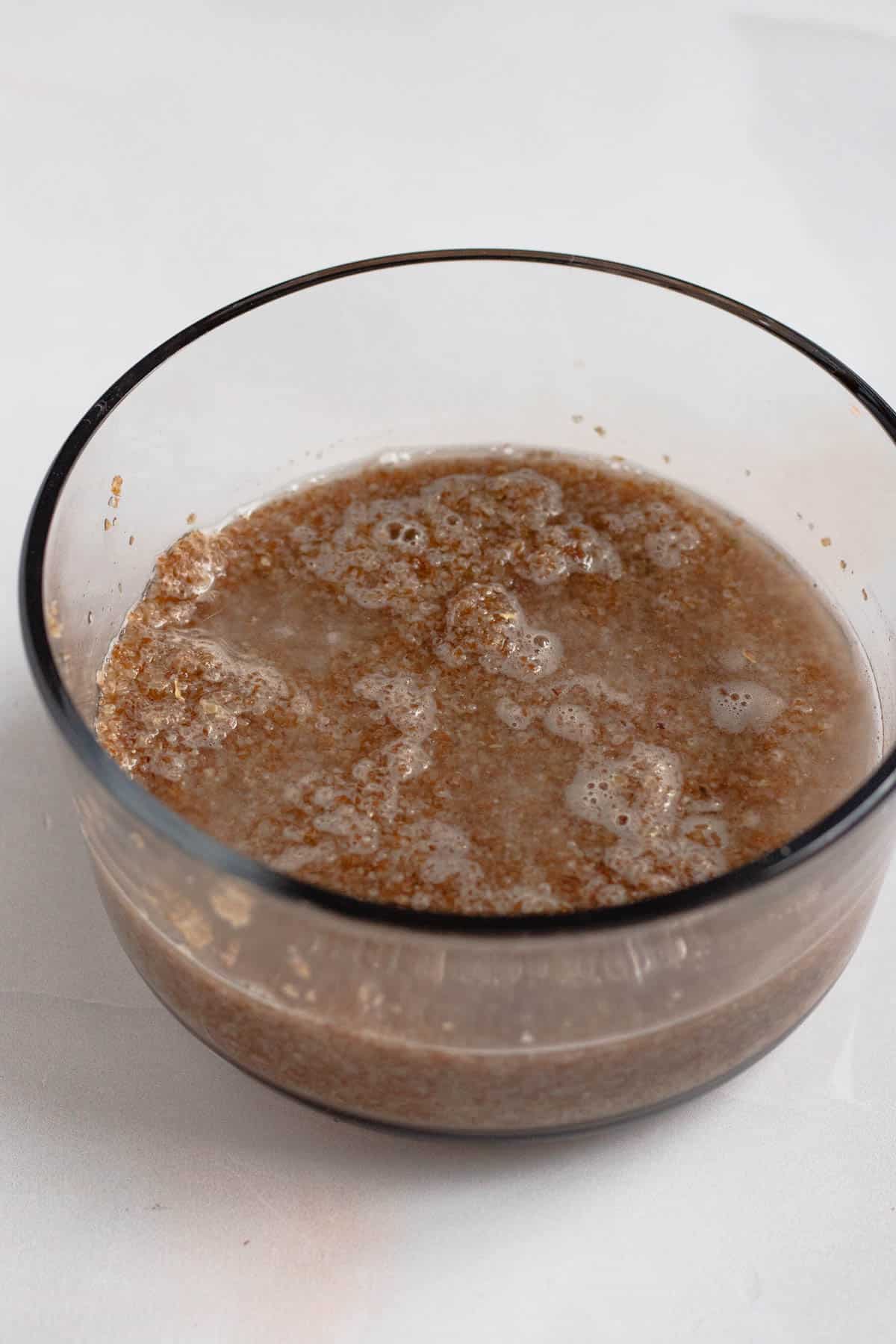
Place the Bulgur Wheat in a small bowl and add the water. Allow it to soak for 15 minutes until all of the water is absorbed. Fluff this with a fork and set aside.
Step Two: Blend
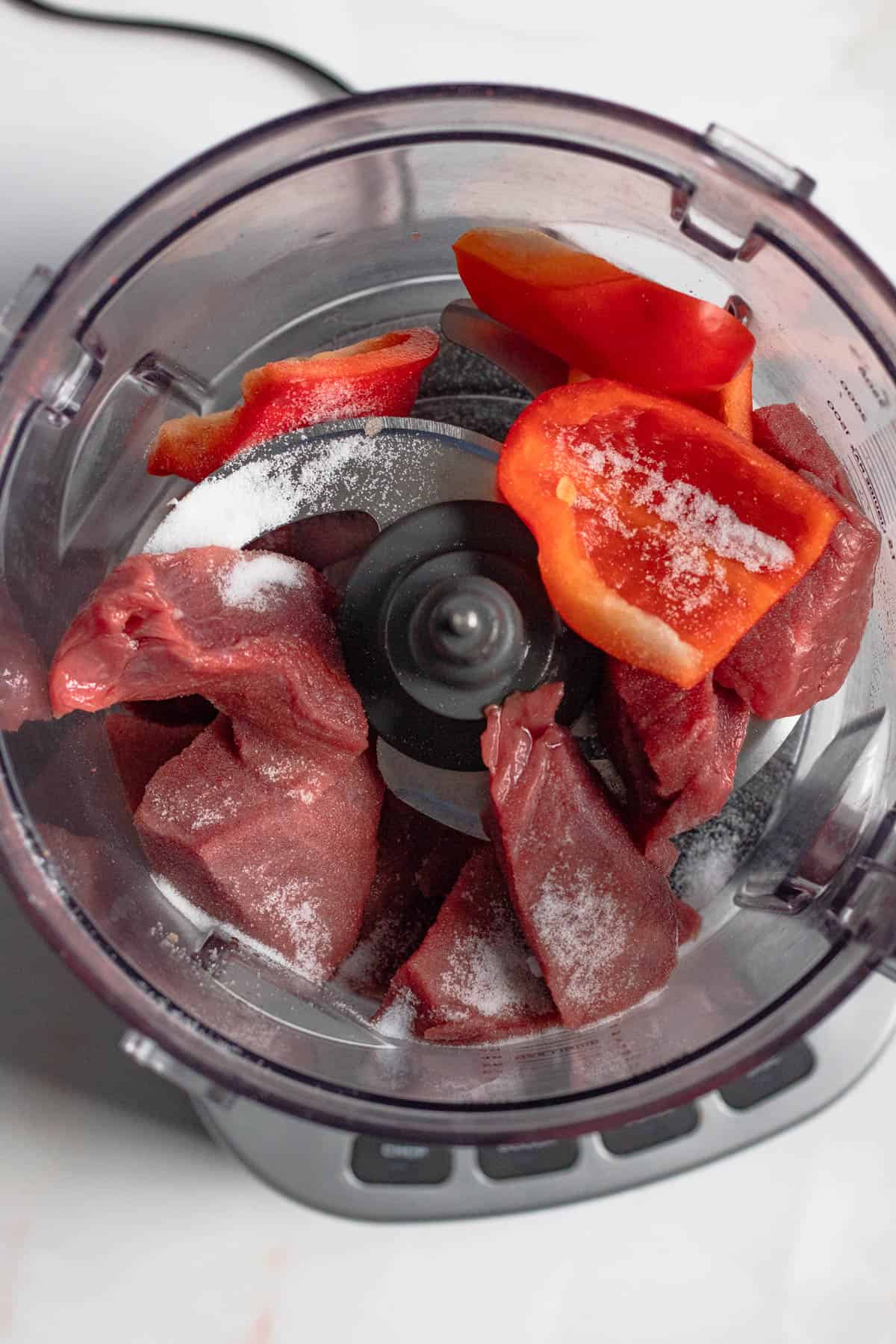
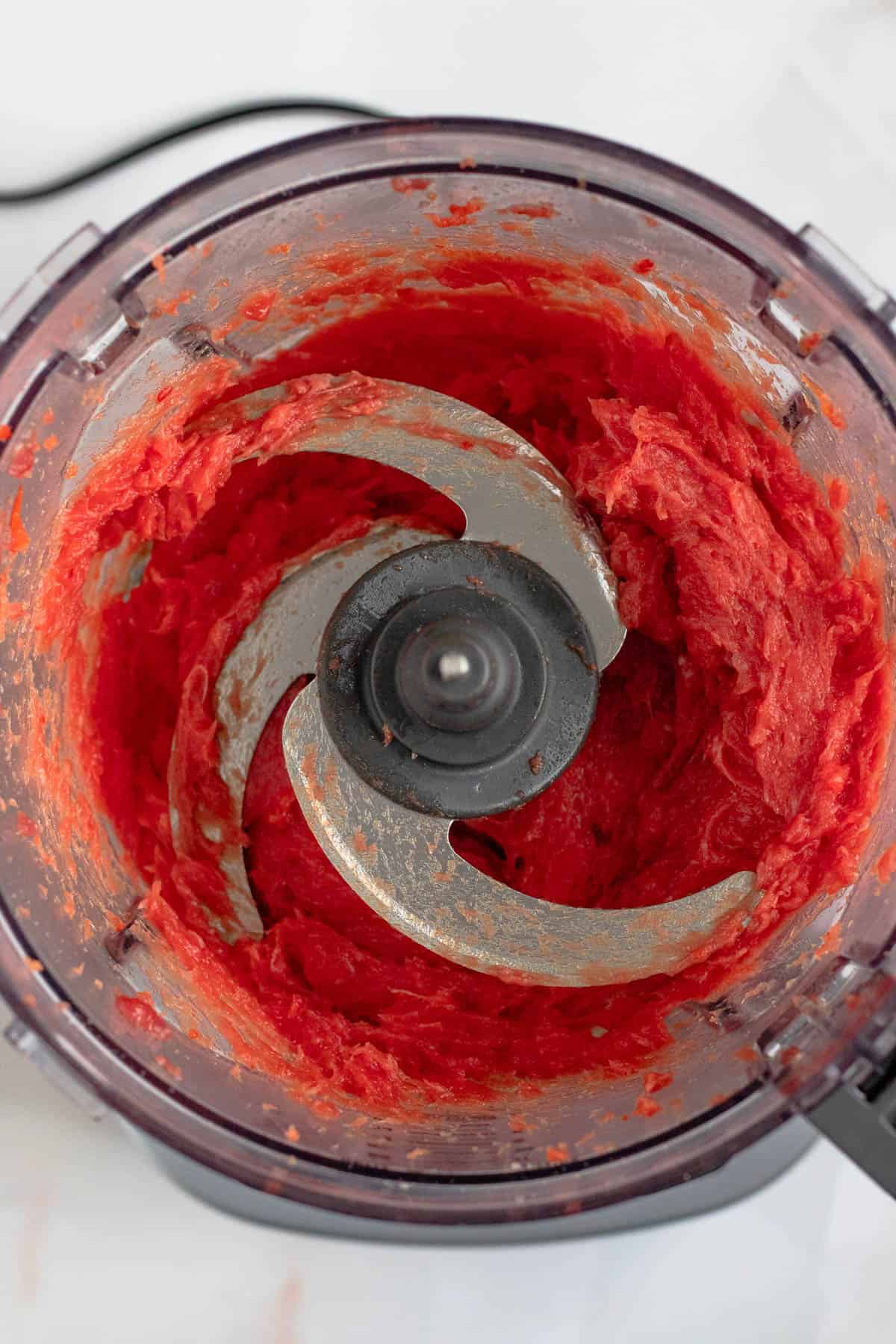
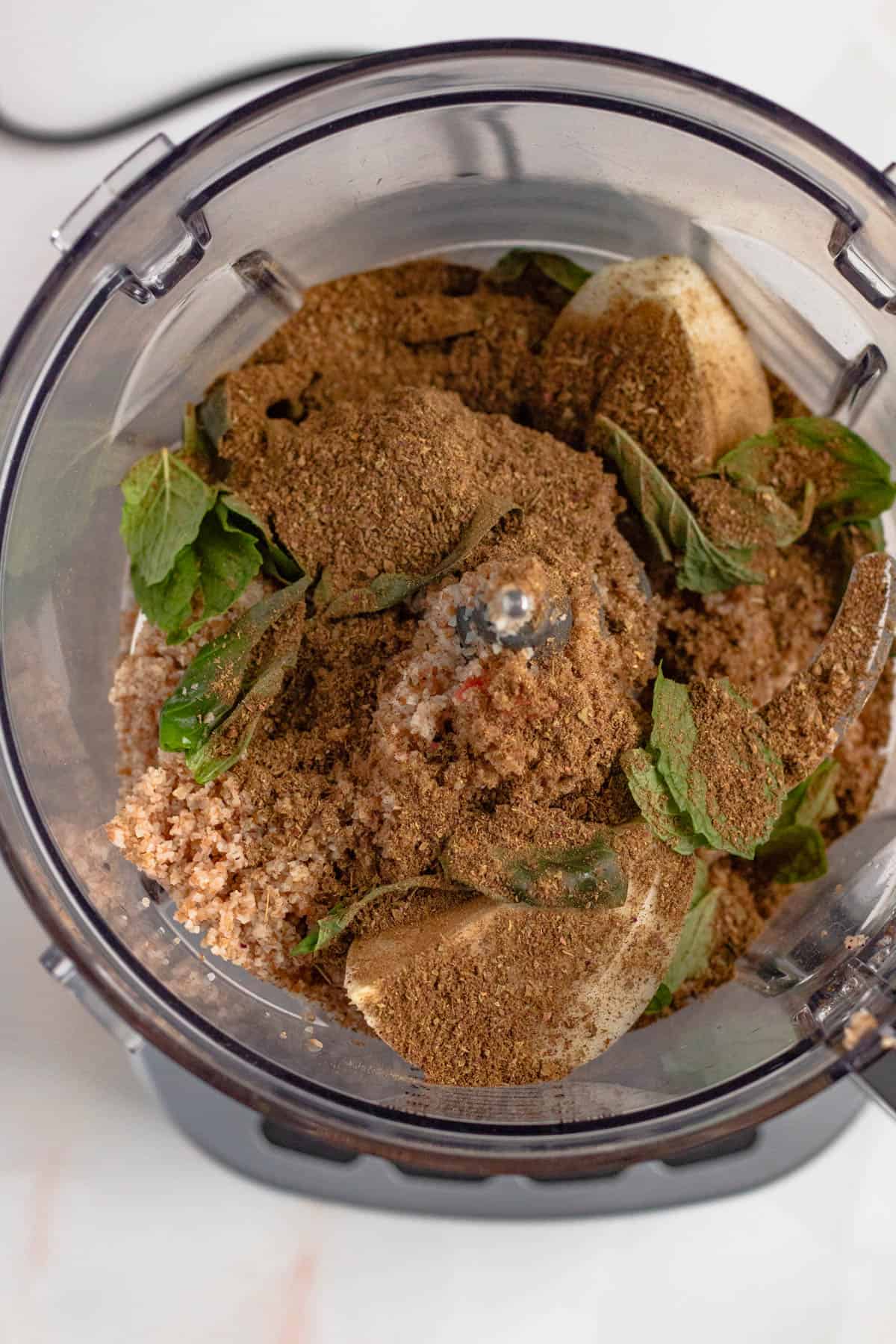
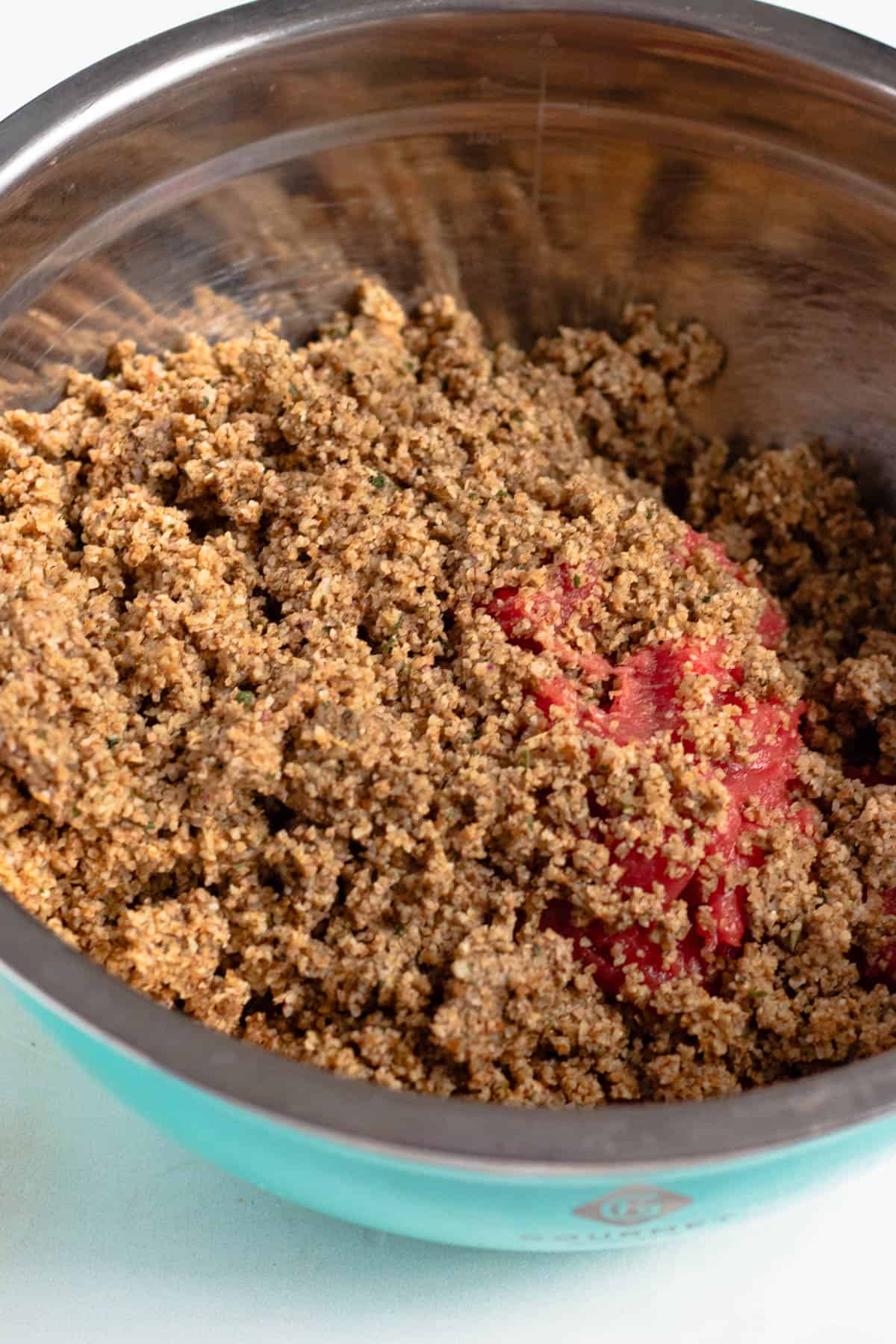
Place the cubed meat in a good food processor along with the red pepper and salt. Blend the meat in the food processor for about 2-5 minutes (depending on your food processor), until the meat is broken down all of the way.
Remove the meat from the food processor and place in a covered bowl in the fridge.
Add the soaked bulgur wheat, sweet onion, basil leaves, mint leaves, and the spice blend into the food processor. Blend until combined.
Remove the mixture of beef from the fridge and add the bulgur mixture to it. Knead the two mixtures together until they are evenly combined and smooth. This should take about 5 minutes.
Step Three: Serve
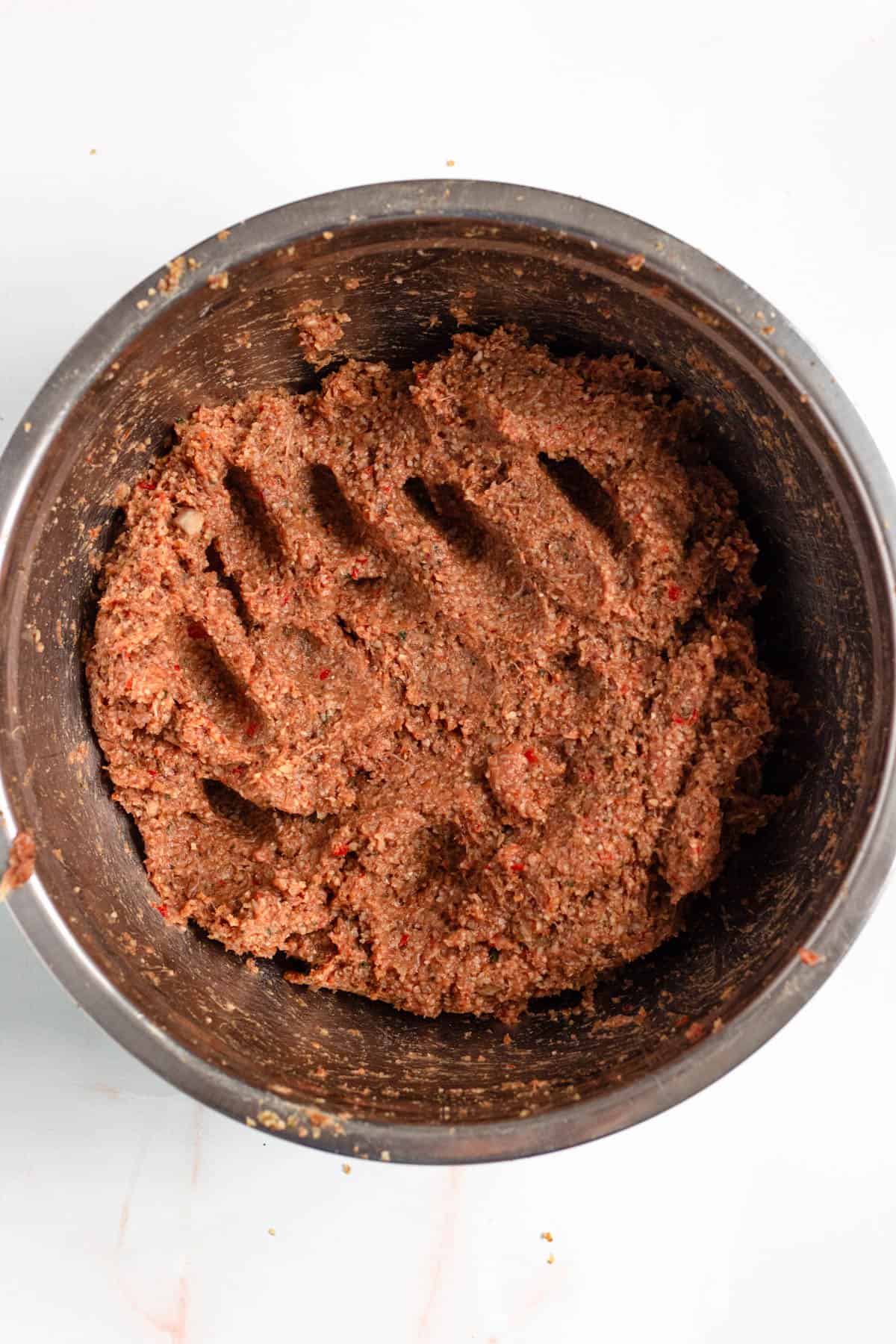
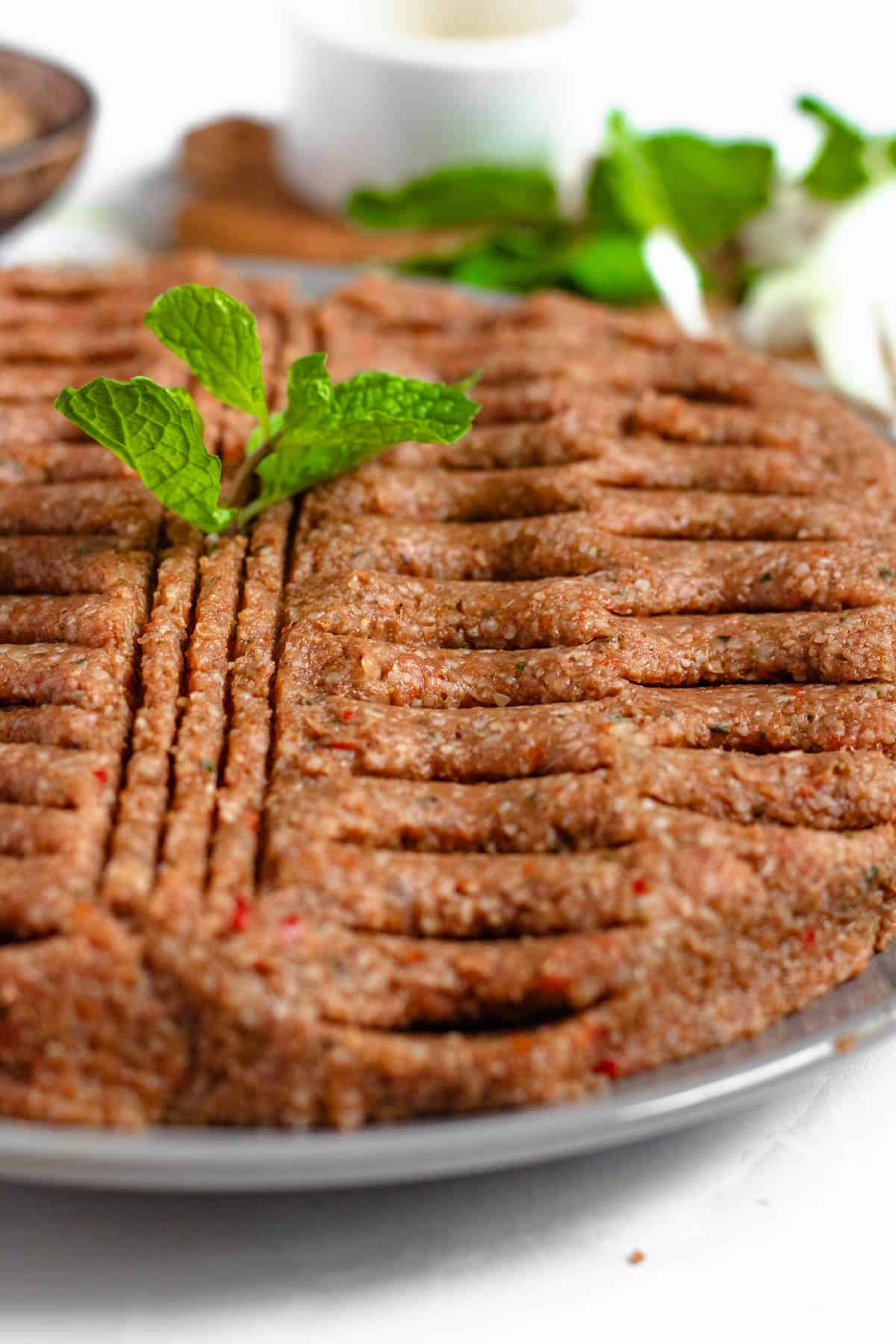
Press the Kibbeh Nayeh thinly onto a serving dish and use your fingers or a spoon to press a nice decoration into the top.
Drizzle the top with olive oil and serve with pita bread and Toum (Lebanese Garlic Sauce)! Enjoy.
Thank you to Layla Ghazaleh from Lebanon for teaching me how to make this recipe!
Safety Precautions for Making this Dish
Kibbeh Nayeh can be perfectly safe to eat as long as it’s prepared and handled properly. Here are some tips to keep in mind when sourcing ingredients and preparing your recipe:
- You want the freshest meat possible. It’s a good idea to make this dish the very same day that you purchase the meat.
- Only use high-quality meat purchased from a trusted butcher who knows what dish you are making. It should be sliced first thing in the morning to avoid cross-contamination with other kinds of meat.
- Keep the meat refrigerated whenever possible and avoid handling it too much. If your food processor is not able to blend all the meat at once, keep the other portions refrigerated until you are ready for them and work in batches.
- Do not keep leftovers for days on end. You can eat your Kibbeh Nayeh within 24 hours of purchasing the meat. Any amount of time after that, you can use your Raw Kibbeh to make Fried Kibbeh Balls or some other delicious Lebanese dish!
Expert Tips
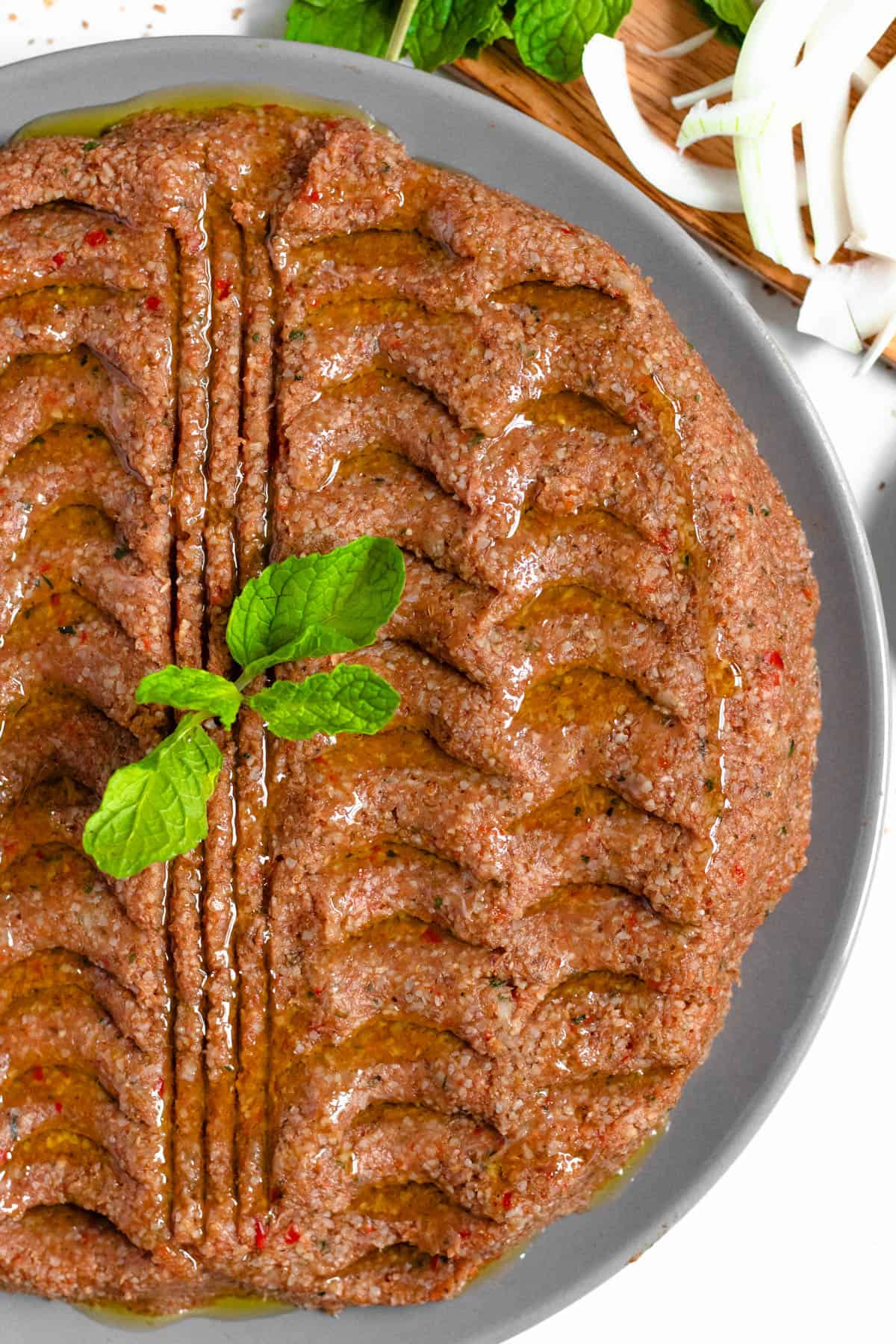
- The oil on top of the dish adds a very authentic flavor. Don’t skip this step!
- The easiest way to decorate your Kibbe is to drag your fork tines across the top of it in a grid pattern!
- I enjoy eating my Kibbeh by opening up a pocket of pita and filling the pita with Kibbeh Nayeh, then adding a slice of onion and a drizzle of olive oil. INCREDIBLE!
Recipe Variations
There are many forms of Kibbeh and different regions highlight different flavors in the dish. Some regions may include a lot of cumin, more black pepper, cayenne pepper or some dried chili powder. Try different flavors!
Recipe FAQs
You’ve probably been told all your life it’s dangerous to eat raw meat dishes. That is true. This dish should be prepared with caution and should probably not be eaten by pregnant women.
The most important part of preparing Lebanese Raw Kibbeh Nayeh the traditional way is starting with fresh ingredients and especially the best meat. Only purchase meat from a trusted butcher whom you have spoken to. Your butcher needs to understand the dish you are making to ensure the meat is prepared correctly.
Most Lebanese butchers who sell meat for this purpose will require you to order it ahead of time so they can make sure it is prepared first thing in the morning before anything else is sliced on their equipment. Some butchers may offer to grind the meat with their meat grinder but using a food processor should be enough to reach your desired texture of ground meat.
To serve this dish, lay it out on a large plate and pat it down thinly with your fingers. Use the prongs of a fork to imprint a design in the meat and then a drizzle of olive oil on top.
Serve with plenty of warm pita bread or Arabic bread and fresh crunchy veggies like cucumber, radish, bell peppers, green onions and white onion. You can also garnish your Kibbeh Nayeh with fresh herbs like mint or basil. Tear pieces of bread and scoop up pieces of meat for each bite.
You can serve Kibbeh Nayeh as an appetizer or a main dish.
It’s not a good idea to store Kibbeh Nayeh in its raw form to enjoy later, however, you can form it into balls and bake or fry them to enjoy later. Reheat the Kibbeh meat later with a bit of olive oil in a pan or in the microwave and serve with a fresh salad.
Kibbeh Nayeh roughly translates to raw Kibbeh. Many variations of Kibbeh are cooked, either baked or fried, but Kibbeh Nayeh is prepared raw.
Did you enjoy this Kibbeh Nayeh Recipe? If so, make sure to check out these other recipes I picked out just for you:
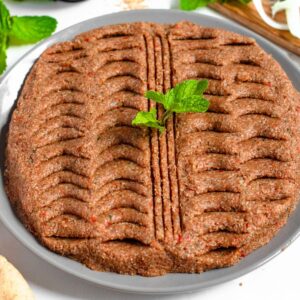
Kibbeh Nayeh (Raw Kibbeh) from Lebanon
Equipment
- Food Processor
- Large Bowl
- Serving Platter
Ingredients
- 1 cup Bulgur Wheat, it was recommended that I use Red Bulgur Wheat but any kind will do
- 1 cup water
- 1 lb lean beef, cubed. My butcher gave me top round. Make sure there is no fat on the meat at all.
- 1 small red pepper, cut into quarters
- 1 ½ tsp salt
- 1 Small Sweet Onion, cut into quarters
- 10 Basil Leaves
- 10 Mint Leaves
- ¼ cup Kamouneh Spice Blend, Kibbeh Seasoning
Instructions
- Place 1 cup Bulgur Wheat in a small bowl and add 1 cup water. Allow it to soak for 15 minutes until all of the water is absorbed. Fluff this with a fork and set aside.
- Place 1 lb cubed meat in a food processor along with 1 small red pepper and 1 ½ tsp salt. Blend the meat in the food processor for about 2-5 minutes (depending on your food processor), until the meat is broken down all of the way.
- Remove the meat from the food processor and place in a covered bowl in the fridge.
- Add the soaked bulgur wheat, 1 small sweet onion, 10 basil leaves, 10 mint leaves, and ¼ cup spice blend into the food processor. Blend until combined.
- Remove the meat mixture from the fridge and add the bulgur mixture to it. Knead the two mixtures together until they are evenly combined and smooth. This should take about 5 minutes.
- Press the Kibbeh Nayeh thinly onto a serving dish and use your fingers or a spoon to press a nice decoration into the top.
- Drizzle the top with olive oil and serve with pita bread. Enjoy!
Notes
- Bulgur Wheat: Bulgar wheat is cracked wheat. I was told to use Red Bulgur Wheat but any kind will do. Fine bulgur wheat will give a better, more delicate texture to the dish. Make sure you use Bulgur #1, which is the finest grain of bulgur!
- Water: You will need to soak your bulgur wheat before using so that is the right texture for mixing with the meat!
- 100% Lean Beef: This dish is traditionally made with beef, lamb or veal. You should only use meat purchased directly from a butcher, and make sure you trust your butcher to give you safely preserved meat. My butcher gave me top round beef. Make sure there is no fat on the meat at all.
- Red Pepper: This is optional. Some people add red pepper, which is an especially beautiful addition for color. If you would prefer to omit the red pepper, you certainly can!
- Sweet Onion: I’ve also seen Kibbeh made with white onion. Feel free to substitute that if you prefer!
- Herbs: Fresh Mint & Basil Leaves.
- Kamouneh Spice Blend (Kibbeh Seasoning): You can find this at a local Middle Eastern Grocery store or make your own using this recipe
- The oil on top of the dish adds a very authentic flavor. Don’t skip this step!
- The easiest way to decorate your Kibbe is to drag your fork tines across the top of it in a grid pattern!
- I enjoy eating my Kibbeh by opening up a pocket of pita and filling the pita with Kibbeh Nayeh, then adding a slice of onion and a drizzle of olive oil. INCREDIBLE!



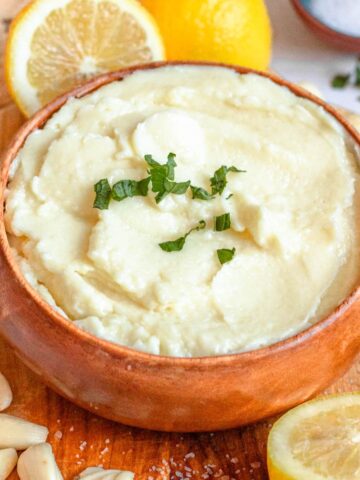
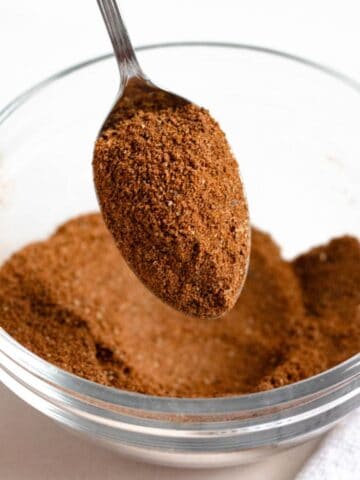

Josie says
Hi, I am lebanese and have made this recipe for 55 years with my grandmother and mother.
My family don’t use beef in this recipe, only lamb. And we dont destroy the meat in a food processor. We bone out the lamb and mince it from scratch along with the onions herbs and spices.
Alexandria Drzazgowski says
Hi Josie, thats good to know. Just because your family does it one way does not mean that that is the only correct way to make this dish. I received this recipe from a Lebanese woman that was very excited to share her family’s recipe with me. Giving a recipe 2 stars when you haven’t tried it just because it’s not the way your grandma did it is very rude.